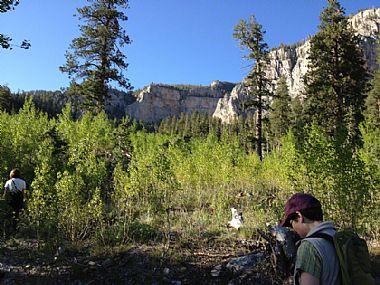 Sue was up ahead, following the proposed trail route through serviceberry brush, ponderosa, white fir, and aspen. We were scoping the site for avalanche evidence, and I knew I should catch up, but... wait... what's that shape in that rock? I stooped down for a closer look: a circular fossil with small radiating lines - probably a rugose coral. And what about that one? And that one? I knew I should catch up, but my naturalist's soul was tuned to the Carboniferous, and I just couldn't tune out.
Sue was up ahead, following the proposed trail route through serviceberry brush, ponderosa, white fir, and aspen. We were scoping the site for avalanche evidence, and I knew I should catch up, but... wait... what's that shape in that rock? I stooped down for a closer look: a circular fossil with small radiating lines - probably a rugose coral. And what about that one? And that one? I knew I should catch up, but my naturalist's soul was tuned to the Carboniferous, and I just couldn't tune out.
The Spring Mountains are an island of tall limestone peaks that rise from the Mojave Desert just a few miles west of Las Vegas. They're truly a world apart: thousands of feet above the cracked desert floor, draped in cool pine forest and tundra. Our job is to create interpretive and orientation exhibits for this very popular National Recreation Area.
On a breezy May morning, geologist Steve Rowland of UNLV met us for a walk down the planned Kyle Canyon Trail and an expedition to Cathedral Rock Picnic Area. By noon, his experience, knowledge, and love of the subject had tuned our ears to the stories in the stones - and the stories were spellbinding.
The strange formations along the road to Kyle Canyon told of wetter, Pleistocene climates when perennial streams tumbled stones down from the peaks, filling the canyon with hundreds of feet of rubble. Gradually, calcite deposits cemented the rubble into "fanglomerate" and flash floods sculpted it into the hoodoos and cave-riddled escarpments that line the road.
The varying hues of limestone in Mummy Mountain, Cockscomb Ridge, and Mt. Charleston told of rising and falling sea levels, and an Antarctic ice cap that waxed and waned on a timescale that ran into the tens of millions of years.
And those pale shapes in the gray boulders and pebbles? Cones, ovals, circles, fans, reticulations... Over 300 million years ago, when there were dragonflies the size of ravens, and dinosaurs were still almost 100 million years in the future, this place lay at the bottom of a shallow sea - and these rocks were reefs, alive with horn corals, brachiopods, crinoids, and bryozoans.
No wonder that for our last half-day, as we explored the site and discussed our interpretive approach, our eyes strayed again and again to the rocks below, above, and around. Fossils, seas, sharks and floods... the rocks were telling their stories, and we couldn't stop listening.
I recently had the opportunity to leave my desk and get into the field for the installation of the Volcanic Legacy Scenic Byway sign that we developed for ODOT. I was surprised at both the beauty and ruggedness of the terrain in Southern Oregon!
